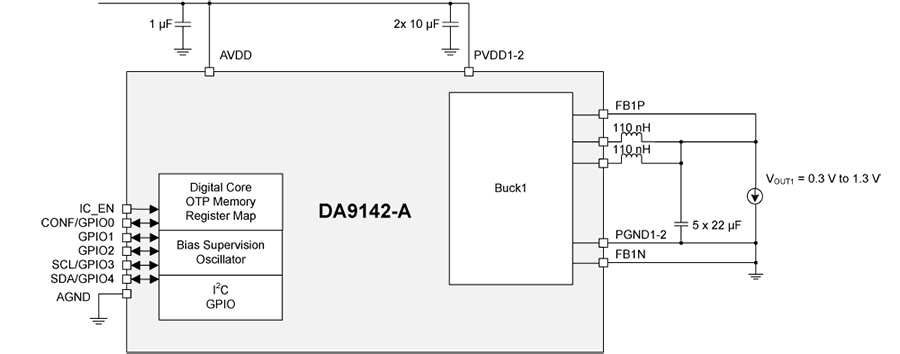Package Information
| CAD Model: | View CAD Model |
| Pkg. Type: | FC-BGA |
| Pkg. Code: | |
| Lead Count (#): | 60 |
| Pkg. Dimensions (mm): | 4.5 mm x 7 mm |
| Pitch (mm): |
Environmental & Export Classifications
| ECCN (US) | EAR99 |
| HTS (US) | 8542.39.0090 |
| Moisture Sensitivity Level (MSL) | 3 |
| Pb (Lead) Free | Yes |
Product Attributes
| Lead Count (#) | 60 |
| Advanced Features | 20A peak dual phase, Integrated FETs. Output voltage 0.3V – 1. 9V |
| Automotive Rating | Yes |
| Carrier Type | Tray |
| Comm. Interface | I2C |
| Function | 1-ch PMIC |
| GPIOs (#) | 5 |
| Input Voltage (Max) (V) | 5.5 |
| Input Voltage (Min) (V) | 2.8 |
| Input Voltage Range (V) | 2.8 - 5.5 |
| Linear Output | No |
| Moisture Sensitivity Level (MSL) | 3 |
| Multi-Phase Support | fixed |
| Output Current Max (A) | 13 |
| Outputs (#) | 1 |
| Parametric Category | System PMIC |
| Pb (Lead) Free | Yes |
| Pkg. Dimensions (mm) | 4.5 mm x 7 mm |
| Pkg. Type | FC-BGA |
| Published | Yes |
| Switching Frequency (MHz) | 4 - 4 |
| Switching Regulators | 1 |
| Temp. Range (°C) | -40 to +125°C |
| Total step-down DC/DC converter channels (#) | 1 |
| VIN Range (V) | 2.8 - 5.5 |
Resources for DA9142-A
Description
The DA9142-A is a high-efficiency, automotive-grade, high current, dual-phase, step-down DC/DC (buck) converter with integrated switching FETs. The device can drive loads up to 20A and is well suited for powering high-performance AI/graphics processor cores in today’s complex automotive SoCs.
The device has an input voltage range of 2.8V to 5.5V and an output voltage range of 0.3V to 1.3V, making it suitable for a wide variety of low voltage systems. The DA9142-A only requires a minimum number of discrete components to operate, delivering a highly optimized BOM and footprint.
The DA9142-A device is part of the Renesas family of flexible, scalable, reliable automotive-grade PMICs enabling an "Exact-Fit" power solution. It is available in a 4.5mm x 7.0mm, 60-pin FC-BGA package. A commercial-grade version is also available (DA9142).
Benefits
- Multiphase operation delivers better transient performance, lower losses, better efficiency, optimized thermal dissipation, and minimized ripple current and voltages when compared to a single-phase architecture
- Lower PCB costs and smaller components with lower overall heights for low profile applications
- Flexibility - Offers the opportunity to optimally place the inductors and capacitors close to the point of load
- Distributed power dissipation – more even distribution of heat – critical for efficient thermal management
- Remote sensing guarantees the highest accuracy and supports multiple PCB routing scenarios without loss of performance
- Fully programmable soft-start limits the inrush current from the input to give a slope-controlled output voltage
- Dynamic Voltage Control (DVC) enables adaptive adjustment of the supply voltage dependent on the load. This increases efficiency when the downstream circuitry enters low power or idle mode, resulting in power savings
- Configurable GPIOs support a range of features including I2C, DVC and Power-Good indicator
